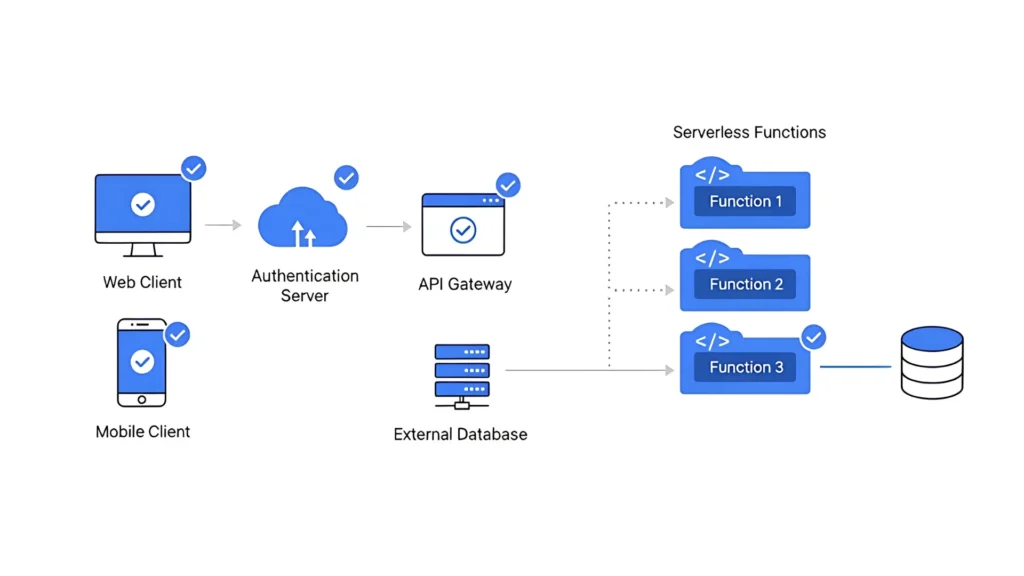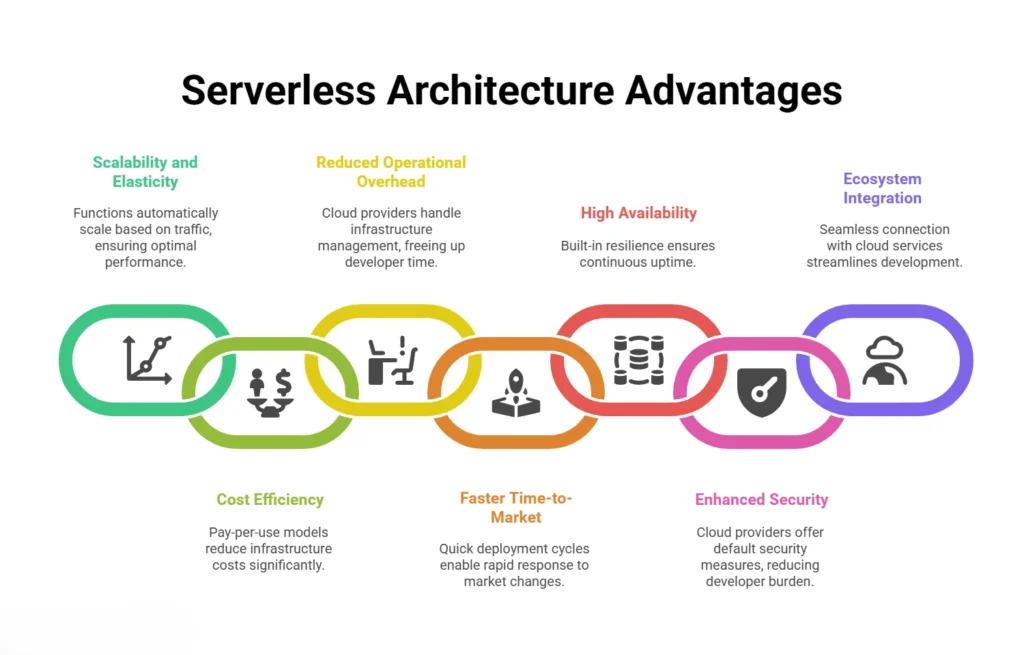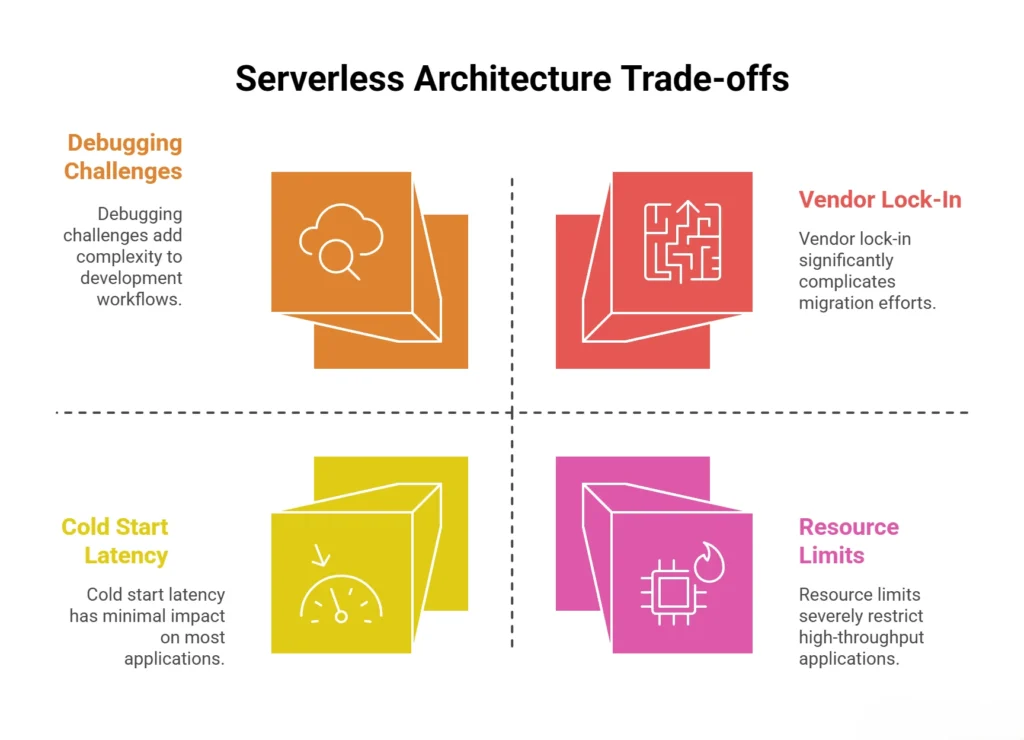Serverless architecture advantages are becoming too significant for modern development teams to ignore. With over 75% of organizations embracing serverless in 2025 and more than 70% of AWS users relying on Lambda, the shift is a mainstream strategy for building agile, scalable applications.
This rapid adoption reflects how businesses are prioritizing flexibility, cost control, and faster innovation cycles. But like any architectural decision, serverless brings both powerful benefits and important limitations.
In this blog, we’ll break down the 7 major serverless architecture advantages and disadvantages in 2025. With this, you can easily evaluate where it shines and where it still falls short.
Serverless Architecture Overview

Before diving into the core serverless architecture advantages, it’s important to understand how this model works and why it’s influencing the future of web development.
Serverless computing allows developers to write and deploy code without worrying about managing servers, scaling, or infrastructure provisioning. Moreover, all of this is handled automatically by cloud providers.
What is Serverless Computing?
Serverless computing is a cloud-native development model where applications run in stateless compute containers that are event-triggered. Moreover, it also includes fully managed and automatically scaled features.
Furthermore, among all the serverless architecture advantages, the most significant is that developers only need to focus on writing code, not managing the underlying infrastructure. As a result, this makes it easier to experiment, deploy faster, and innovate more frequently.
How Serverless Works (FaaS, BaaS)
There are two main models in serverless: Function-as-a-Service (FaaS) and Backend-as-a-Service (BaaS). With FaaS (like AWS Lambda or Azure Functions), you execute discrete units of logic in response to events.
In addition, BaaS (like Firebase or AWS Amplify) provides ready-made backend services such as databases, authentication, and storage. Thus, letting you skip boilerplate backend code entirely.
Together, these models simplify development, speed up product cycles, and align with the agility demanded by modern digital teams.
7 Major Serverless Architecture Advantages
Now that we’ve covered the basics, let’s explore the serverless architecture advantages that are driving its widespread adoption in 2025. From scalability to security, serverless delivers unique value for developers, startups, and enterprises alike.

1. Scalability and Elasticity
One of the biggest serverless architecture advantages is its built-in scalability. Functions automatically scale based on traffic, whether it’s one request per minute or a million per second. This is a game-changer for businesses with unpredictable traffic patterns or high-growth products.
Unlike traditional infrastructure, there’s no need to pre-provision resources or worry about auto-scaling rules. Thus, this elasticity makes it ideal for digital platforms that are part of the evolving future of web development.
2. Cost Efficiency and Pay-Per-Use Models
Secondly, serverless billing models are based on actual usage, not idle capacity. You only pay for the compute time consumed per function execution. As a result, this makes this one of the more practical serverless architecture advantages for startups and cost-conscious businesses.
Also, there’s no need to maintain always-on servers or guess your monthly usage in advance. For companies looking to optimize infrastructure spending, this shift can result in meaningful savings.
3. Reduced Operational Overhead
Forget patching, managing load balancers, or monitoring CPU usage. With serverless, all of this is handled by your cloud provider. This reduced operational burden is one of the most underrated serverless architecture advantages, especially for lean dev teams.
Thanks to this, engineers can focus on shipping features, not maintaining infrastructure. It also leads to faster deployments and fewer late-night firefights.
4. Faster Time-to-Market
Serverless development speeds up product cycles. Developers can release features faster by leveraging cloud-native services and prebuilt components. This is one of the key benefits of serverless computing, allowing businesses to respond quickly to user feedback or market shifts.
Without the need to configure environments or write boilerplate code, teams can move from idea to release in record time.
5. Built-in High Availability
High availability is designed into most serverless platforms by default. Functions are typically deployed across multiple availability zones. Thus, ensuring resilience even if one zone goes down.
This makes serverless ideal for applications that demand uptime without requiring teams to manage complex failover systems. It’s another example of how serverless architecture advantages go hand-in-hand with performance and reliability.
6. Enhanced Security (from Cloud Provider Side)
Cloud providers implement security best practices by default, including encryption at rest, identity controls, and network isolation. This offloads much of the security configuration from developers, which is particularly helpful for startups or companies without a full-time security team.
While serverless security concerns still exist (and we’ll cover those later), built-in protections offer one of the initial serverless architecture advantages that appeal to regulated industries.
7. Ecosystem & Easy Integration with Cloud-Native Services
Serverless functions can easily connect with databases, queues, storage, and APIs, all part of the broader cloud ecosystem. This plug-and-play capability accelerates development and aligns closely with the cloud computing reference model.
By taking full advantage of managed services, businesses can streamline architecture and focus purely on business logic. This seamless integration is yet another reason teams are choosing serverless architecture advantages over traditional setups.
6 Disadvantages of Serverless Architecture

Despite the hype and benefits, serverless isn’t without its trade-offs. The same features that make it appealing can also introduce friction points, especially for complex applications or teams with specific infrastructure needs.
While the serverless architecture advantages are hard to ignore, understanding the limitations helps make better architectural decisions.
1) Cold Start Latency
One of the most common issues with serverless functions, especially those not frequently triggered, is cold start latency. The time it takes to spin up a function can delay response times, particularly in latency-sensitive use cases.
This might not affect every app, but if real-time performance is your priority, cold starts can be a bottleneck you can’t afford to ignore.
2) Limited Execution Time
Serverless functions typically have a maximum timeout, often 15 minutes or less. While this works fine for short, stateless processes, it creates limitations for long-running tasks like data migration or video processing.
So, if your business logic doesn’t fit neatly into small, self-contained blocks, serverless may require a rethink or a hybrid architecture.
3) Debugging and Testing Challenges
Debugging locally or testing serverless workflows can be more complex than traditional environments. It often involves emulators, third-party tools, or full deployments just to identify issues.
This makes the development loop slower and requires familiarity with cloud-specific tooling. For teams new to the serverless model, this learning curve can feel steep.
4) Vendor Lock-In
One of the major drawbacks of serverless architecture is vendor lock-in. Many serverless offerings are tightly coupled with their cloud provider’s ecosystem. While this ensures seamless integration, it also makes migrating away difficult.
If you build around AWS Lambda or Azure Functions, switching providers might mean rewriting large chunks of your codebase. The trade-off is worth considering early, especially if portability is a long-term goal.
5) Resource Limits
Serverless functions come with predefined memory and CPU limits. If your app needs to handle large computations or parallel processing, these caps can be restrictive.
Though you can architect around it using queues or microservices, it often adds unnecessary complexity for scenarios that traditional servers would handle more efficiently.
6) Not Ideal for All Use Cases
Some workloads, such as sustained high-throughput applications or complex, tightly coupled systems, may not benefit from going serverless. In such cases, containerized or VM-based solutions offer more control, predictability, and flexibility. Knowing when not to use serverless is just as important as knowing when to adopt it.
Important: Despite these trade-offs, the serverless architecture advantages often outweigh the cons, if the fit is right.
Serverless vs. Traditional Architecture in 2025
The architectural landscape in 2025 is evolving rapidly, and so are the choices. Whether you’re building a startup MVP or scaling an enterprise platform, the debate between serverless vs traditional architecture is more relevant than ever.
Understanding the serverless architecture advantages in context helps tech leaders and developers pick the right path, not just the trendiest one.
Core Differences
Traditional architecture relies on long-running servers, manual provisioning, and infrastructure management. You have direct control but also full responsibility for uptime, scalability, and resource optimization. In contrast, serverless abstracts away infrastructure, automatically scaling based on demand and billing only for execution time.
However, serverless isn’t “set and forget.” It introduces new concerns like cold starts, limited runtime, and tighter integration with a provider’s ecosystem.
Moreover, for some applications, this is a trade-off worth making. For others, especially those with predictable and consistent workloads, traditional servers may be the better choice.
Also, before transitioning, use a cloud migration checklist to assess whether your app architecture, team readiness, and performance needs align with a serverless environment. Misalignment here can lead to friction down the line.
When to Choose Each Approach
Choose serverless when your application demands fast deployment, flexible scaling, and pay-as-you-go cost optimization. It’s ideal for APIs, background tasks, and event-driven logic, especially in startups and agile teams.
The serverless architecture advantages truly shine in innovation cycles where iteration speed is critical.
Traditional architecture makes sense when you need long-running processes, custom server configurations, or compliance-heavy control over the environment. It also offers consistency for legacy workloads and performance tuning for highly specific use cases.
In many cases, a hybrid model works best, combining the agility of serverless for some components with the robustness of traditional infrastructure for others. Regardless of your choice, what matters most is architectural clarity and long-term maintainability.
Remember: Both models offer unique strengths, but knowing where the serverless architecture advantages apply gives you the competitive edge.
Best Practices for Serverless Adoption
Implementing serverless isn’t just about writing a few Lambda functions and calling it a day. To fully unlock serverless architecture advantages, businesses must follow tried-and-tested best practices that address real-world challenges.
From security to cost optimization, strategic planning makes all the difference in long-term success.
Security Hardening Tips
Security in a serverless environment is fundamentally different. Since there’s no traditional perimeter, focus shifts to identity, permissions, and data flow control. Use the principle of least privilege aggressively, functions should only access what they need. Integrate tools for real-time security event logging and validate inputs across all APIs.
In addition, stay updated with vendor-specific guidelines. For instance, you can refer to Microsoft’s Azure serverless case study that highlights how fine-grained IAM policies and centralized monitoring helped mitigate risks for enterprise-scale apps.
Lastly, consider adding layers like WAF, API Gateway throttling, and encrypted environment variables to improve resilience.
Cost Control and Monitoring
One of the most attractive serverless architecture advantages is its billing model, you pay only for what you use. But without active monitoring, costs can quietly spiral. Therefore, use alerts to monitor function invocations, memory usage, and duration.
Also, limit retry attempts for asynchronous events to avoid runaway charges. And, adopt tagging strategies to break down usage by function, team, or environment. Real-time dashboards and APM tools like CloudWatch, New Relic, or Datadog also help identify performance issues early.
So, while serverless helps lower infrastructure overhead, cost management is still a continuous discipline, just like in any other architecture.
Conclusion: Serverless Architecture Advantages
As modern systems demand greater agility and efficiency, the serverless architecture advantages offer a compelling edge like faster deployments, auto-scaling, and minimal infrastructure management.
However, the key lies in smart adoption. Aligning the architecture with your application’s needs and preparing your team to handle the unique operational dynamics of serverless will ensure that you’re building resilient systems.
FAQs about Serverless Architecture Advantages
1. Is serverless architecture suitable for all applications?
Not necessarily. Serverless works best for stateless, event-driven workloads but may not be ideal for high-throughput or long-running processes.
2. What are the key serverless architecture advantages over traditional models?
They include auto-scaling, reduced operational overhead, and a pay-as-you-go cost structure that minimizes waste. These benefits can be especially impactful for startups and agile teams.
3. How does serverless affect DevOps practices?
It changes the focus from infrastructure management to automation, monitoring, and CI/CD workflows. Moreover, teams must adopt new tools and observability strategies.
4. Can serverless lead to vendor lock-in?
Yes, especially if you’re heavily using platform-specific services. Abstracting logic and using standard tools can reduce this risk.
5. What skills does a developer need to work in a serverless environment?
They should be comfortable with cloud functions, API gateways, and event-driven design. Understanding serverless architecture advantages helps in optimizing design decisions from the start.







